“It’s mostly Romneys up on that hill, but you can see a few Cotswolds mixed in. Over there are the Shetlands.”
Kim Caulfield flicks a hand toward a nearby pasture as I pick my way after her across the muddy ground. Her sweatshirt, emblazoned with the image of a sheep, says, “To baa or not to baa.” She is wearing a headband, which she knit herself, from yarn she spun and dyed herself, from sheep she raised herself. Kim walks with solid purpose, cutting a deliberate path across the soggy yard. Around us stand several large, fluffy Newfoundland dogs, and I have the odd sensation that I’m amongst a herd of friendly polar bears.
She is wearing a headband, which she knit herself, from yarn she spun and dyed herself, from sheep she raised herself.
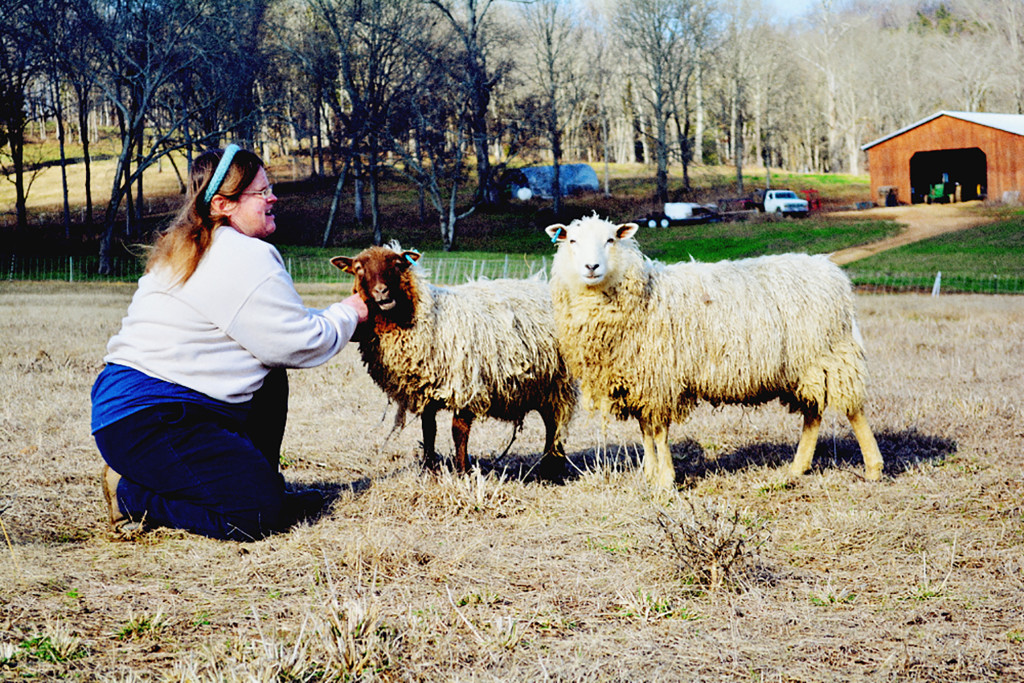
I glance up amid careful puddle dodging and see the Shetland sheep bunched together in their paddock. They are small and nimble with large, glassy eyes, and they skitter away nervously as we pass. A few hop, and one is unable to suppress an alarmed bleat.
Kim looks at me and grins.
Kim and her mother, Jane Caulfield, raise sheep on Far Out Farm in Delina, Tennessee, a one-stop-sign town nestled in the rolling hills about an hour south of Nashville. What started as a hobby twenty-five years ago has become a full-time business, with a flock of over a hundred sheep.
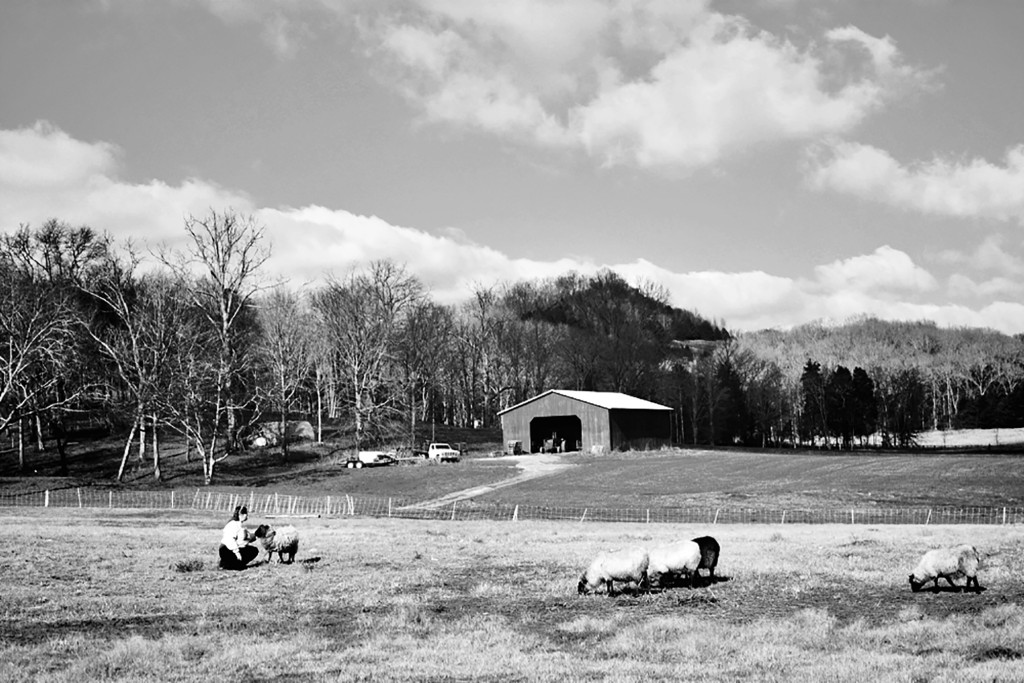
When I ask them how they got into it, they both laugh and point a finger at the other.
“It’s her fault; she signed me up for weaving lessons,” Kim explains.
“It’s her fault, she really liked them,” Jane replies.
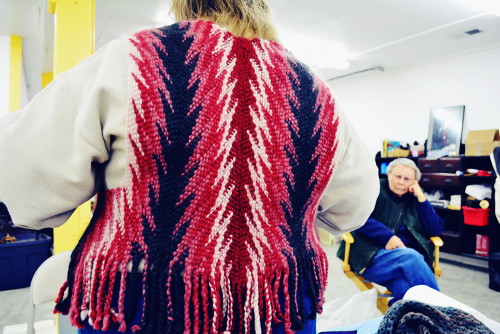
Ancient Wool
One of Kim’s most prized possessions is a glass spindle dated to around the early second century. She gets it out of a case to show me. A spindle is a tool that twists wool fibers into yarn – the spinning wheel wasn’t invented until around the year 1200. This one is a fragile rod about eight inches long made from beautifully whorled sea green glass. Both ends curve into a loop, creating eyes through which the wool fibers are passed. Kim hands it to me and I hold it, enthralled and terrified. It is impossibly fragile, unbelievably still in one piece. In places it is smooth with wear.
Kim jabs a finger at it. “Some woman spun yarn with this two thousand years ago,” she says.
For thousands of years, the story of wool has been entwined with that of humanity’s. People began to domesticate sheep nearly 10,000 years ago after realizing that they could provide both food and clothing. The herd animals could easily move with nomadic tribes, and their resiliency and ability to eat woody plants meant they could survive in conditions many other animals could not.
As societies evolved and cultures flourished, millennia of selective breeding created many varieties of sheep with differing characteristics. The Romans were expert shepherds, and as they conquered Europe, their flocks followed. Wool became a highly sought after and highly protected commodity. Spain, where the fine-wool Merino sheep originate, imposed the death penalty on the export of sheep until 1786. England discouraged a wool industry in the American colonies, eventually making it illegal to raise and trade wool there. Like the Tea Act that sparked Boston Tea Party, wool production became one of the many contested issues that led to the American Revolution.
In the following years, the wool industry grew with the onset of the Industrial Revolution, rising to meet the demands of an exploding population with ever increasing purchasing power. Wool began its steady decline following the invention of synthetic fibers in the mid-twentieth century. By the end of the 1990s, the US wool industry had collapsed to half its size. Unable to compete with cheaper overseas production and the emergence of competing wool markets, many sheep farming operations were shuttered. Today, the industry is dominated by Australia, China, and New Zealand, where sheep outnumber citizens five to one.
In New Zealand, sheep outnumber people five to one.
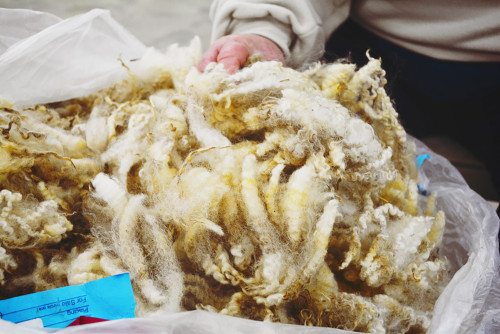
Seasonal Shearing
Sheep shearing at Far Out Farm takes place in February; in cooler areas of the country, it generally takes place between March and June. Shearers, many of whom travel for work, are hired in for the job. Even on the large industrialized sheep ranches where herds may number in the tens of thousands, there is still no way to safely remove a fleece from a sheep except by hand, one at a time. In-demand shearers sometimes work half the year in the northern hemisphere and the other half in the southern.
One might expect the shearing to take place in the summer when it’s the hottest, but it is actually timed so that the sheep have grown a bit of fleece back by summer. Because of wool’s insulating properties, sheep with an inch of fleece are actually cooler than sheep with no fleece. Sheep are unable to sweat; they pant like dogs when their body temperature gets too high, so overheating must be avoided.
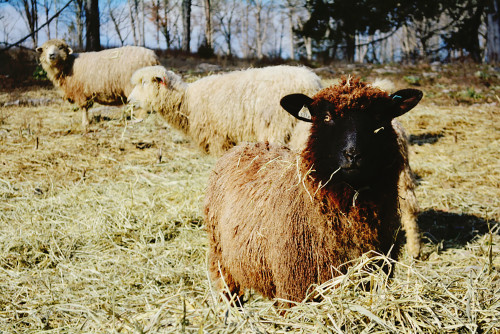
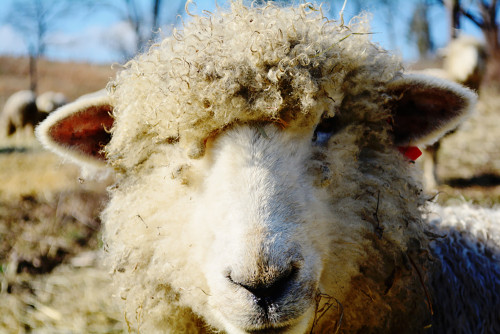
The ups and downs of a sheep’s year are recorded in every strand of their wool. If a sheep is sick or stressed, that point in the fleece is weakened and more prone to breakage. Intense heat can produce yellowed wool. Just like human hair, fleece is synthesized protein, so a well-fed, calm sheep will produce the best quality wool. Far Out Farm’s sheep are raised on a diet of grass and hay with a custom-mixed mineral supplement. Kim and Jane avoid the use of fertilizer by carefully rotating the grass varieties they plant in each pasture.
Quality Fleece
For very, very high quality wool, like the wool used for Italian designer suits, some farms jacket their sheep, a practice that dates back to the ancient Romans. The animals actually wear little sheep-sized jackets to protect their fleeces from the elements. As the fleece grows, the jackets are swapped out for successively larger ones. The jacket keeps the fleece snowy white and protects against environmental undesirables like dead plants and bugs. Jacketed sheep are primarily found in Australia and New Zealand, and buyers fly in from around the world to source and purchase these fleeces.
So what makes a fleece better or worse? Softer or scratchier? It mostly comes down to two factors: fiber diameter and fiber length. When wool fabric is placed against the body, the scratchiness is actually created by all the ends of the wool fibers. If the fiber is thin enough, it will bend away when it touches the skin. If it is thick, it remains rigid, registering as a tiny poke. Long fibers mean there are fewer ends to poke the skin; shorter fibers mean more pokes. So the thicker and shorter the fibers in a particular variety of wool, the itchier.
Fine wool, like Merino, is the softest wool to wear. Its fibers have a diameter of under about twenty-five microns (a micron is one-millionth of a meter). At the other end of the spectrum, coarse wool fibers have a diameter of thirty-eight microns or more. This wool is too uncomfortable for clothing and is used for things like carpets and stuffing.
Fiber People
Kim and Jane take me up to the attic of their processing building to look at some fiber. On the way, they proudly show me an elevator that they made, which I wholeheartedly agree is quite impressive. A spinning enthusiast, Kim not only processes her own fiber, but she also buys it from others. She pulls out a tuft of purchased Merino wool and a tuft of her own Romney wool. The Merino is glossy, white, and tightly coiled. The Romney, while still soft, is a bit coarser.
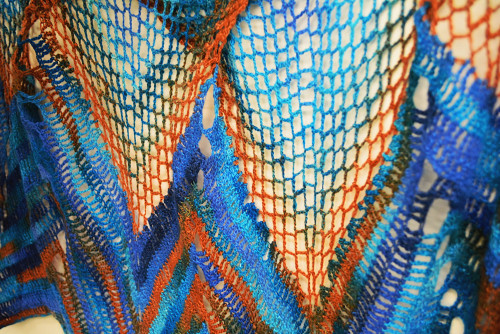
The attic is littered with garbage bags of different fibers like silk, wool, bamboo, and angora. Kim mutters something dreamily about bison fiber, which, allegedly, is very soft.
“If there’s one thing about fiber people,” she says, nudging a dusty bag with her foot. “It's that we always want more fiber."
There are only a few woolen mills left in the United States, Pendleton perhaps being the best well known. Like sheep farmers, woolen mills simply couldn’t compete with cheaper overseas services. However, as with other areas of agriculture, there has recently been a burgeoning new interest in the smaller scale, and a few mills are bravely popping up here and there. One such mill is Northern Woolen Mills in Fosston, Minnesota, where new owner Stephanie Anderson learned how to operate the equipment via YouTube videos.
If there’s one thing about fiber people, it's that we always want more fiber.
These small mills come as great relief to small wool producers, who usually have to ship their raw wool very far to be processed. This is one of the factors that led Kim and Jane to hire an engineer to custom build a mill. It is the same equipment that a large, industrial-sized operation would use. Kim processes their own wool and also offers her services for hire. Her skills are in such high demand that she jokingly tells me to keep quiet about them, because she already has so much regional business that she can’t keep up.
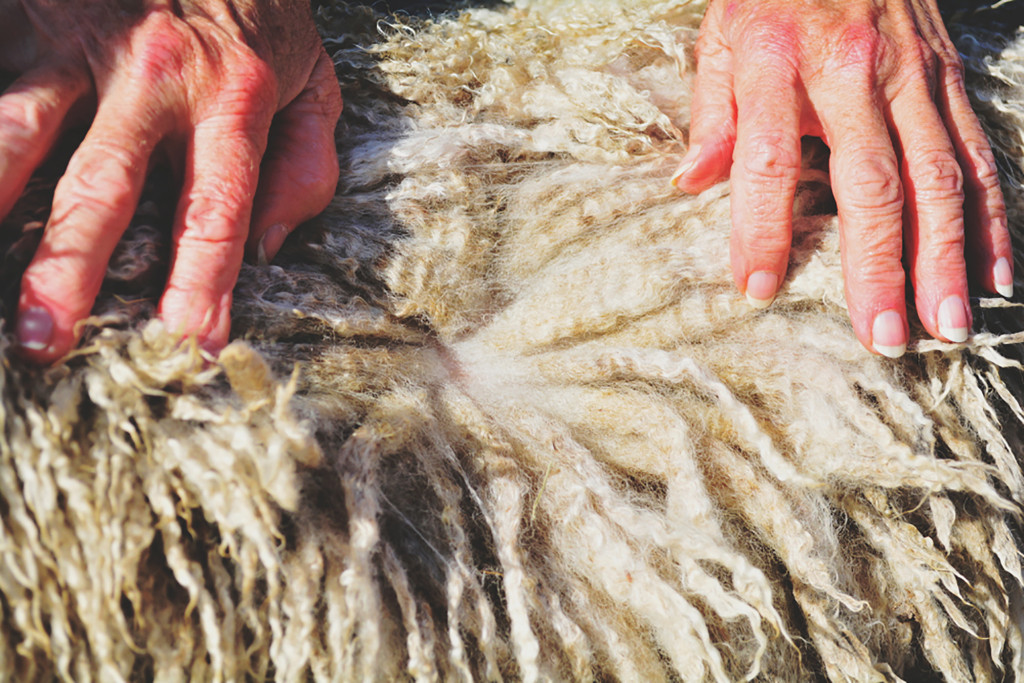
Washing the Fleece
The whole process starts with a fleece, which is the wool from one sheep shorn in a single piece. One average-sized fleece could make about two adult sweaters. First, the unusable parts are removed. These are usually the skirtings, dirty, short-fibered portions, which are around the legs and underbelly of the animal. Kim and Jane stuff the skirtings into burlap bags and use them like sandbags to control erosion around the farm. The wool felts inside the bag and the burlap rots away, leaving something behind that looks disconcertingly like a giant hairball.
Next, the wool must be washed. Raw wool is also called greasy wool, because it is soaked with lanolin. Even just touching it leaves a residue on your hands. The naturally occurring lanolin helps protect the sheep and keep water out; however, it has a rather pungent smell and isn’t desirable in the finished yarn. Not everyone in history agrees on this, though. The well-known Irish fisherman sweaters used to be made with greasy wool. The combination of the lanolin and the minor felting that happened with the ocean damp created a garment that was practically waterproof, if rather stinky.
Kim soaks her batches of wool in cool, soapy water; avoids heat and agitation; and then hangs it in bags to dry. After a few rounds of this, the wool is ready to go, sometimes weighing up to forty percent less after the removal of the lanolin and dirt.
The most important reason to wash wool this way is to prevent it from felting. Have you ever accidentally shrunk a sweater? That’s felting. Wool fibers are covered with little shingles that stick out like barbs—imagine the close-up diagrams shown on shampoo commercials. Sheep’s hair grows with barbs all in one direction, so they are able to flex and move over one another. When the wool is cut and made into fabric, however, the fibers are rearranged and the barbs are all unaligned. If the fibers are agitated, the barbs lock together, irreversibly pulling the fibers close to each other.
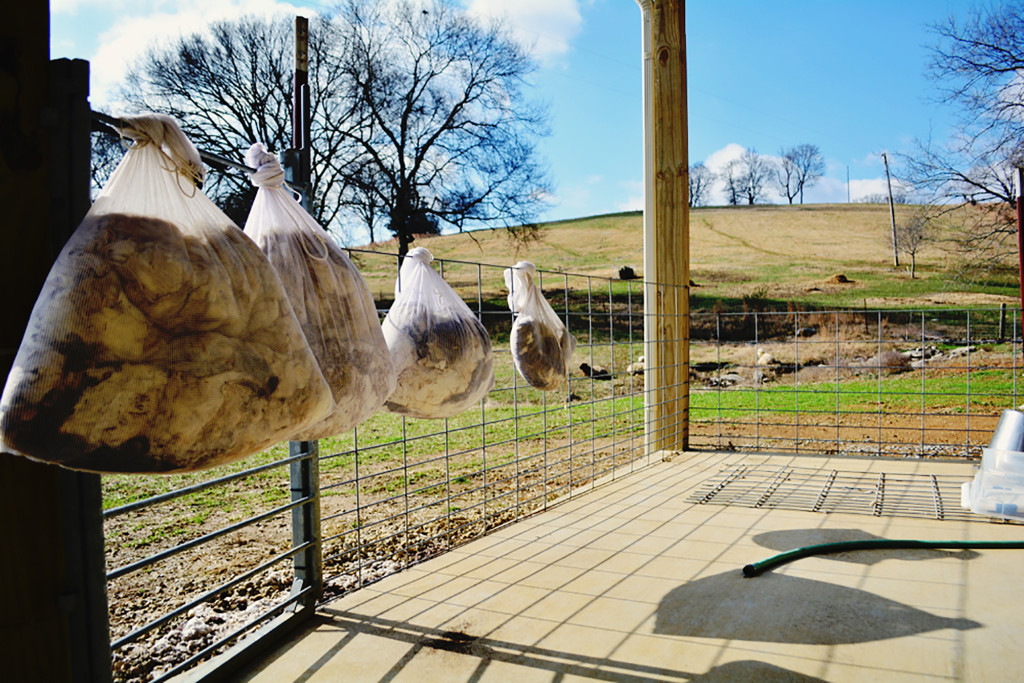
Meet the Machinery
The first machine the wool goes through is the picker. The fiber is loaded onto a conveyor belt, which sends it into a large spinning drum covered with spikes. This initial process starts to comb and separate the fibers and removes any large debris. The machine then shoots the fibers out into a little walled space with a door, essentially a closet built out in the center of the room.
During my visit, Kim has a batch in progress and starts running a little bit of it through so I can watch. The machine rumbles and spins, and the fleece disappears inside. Kim goes around to the back and opens the little door, grinning gleefully as wool fibers fly through the air and settle in fluffy drifts on the floor inside.
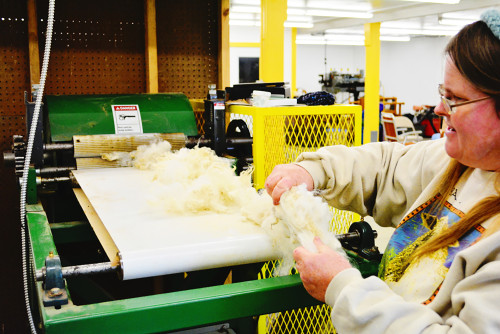
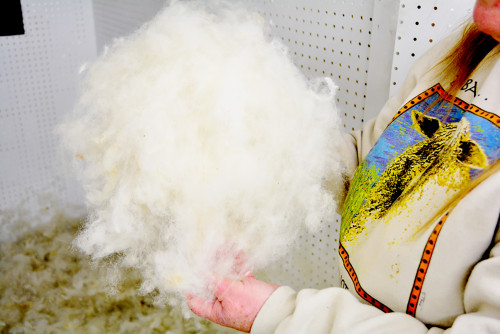
She scoops up armfuls of wool and heads toward the next machine, the carder. This one looks rather like a medieval torture device that someone decided to repaint Kelly green. Drum upon drum, all different diameters, turning at different speeds, and covered with differently spaced spikes, is stacked in the center. The machine is contained in a large metal cage, not unlike a ferocious carnivorous beast, and Kim and Jane are sure to give me a small safety talk before they turn it on.
The drifts of wool are sent down a conveyer belt into the mouth of the machine, where spinning teeth grab and send them flying around the drums. As the wool goes through, spending more time on one drum, less time on another, it gets progressively cleaner and looks smoother. The whole point of carding is to comb the fibers so that they are straight, elongated, and running in the same direction.
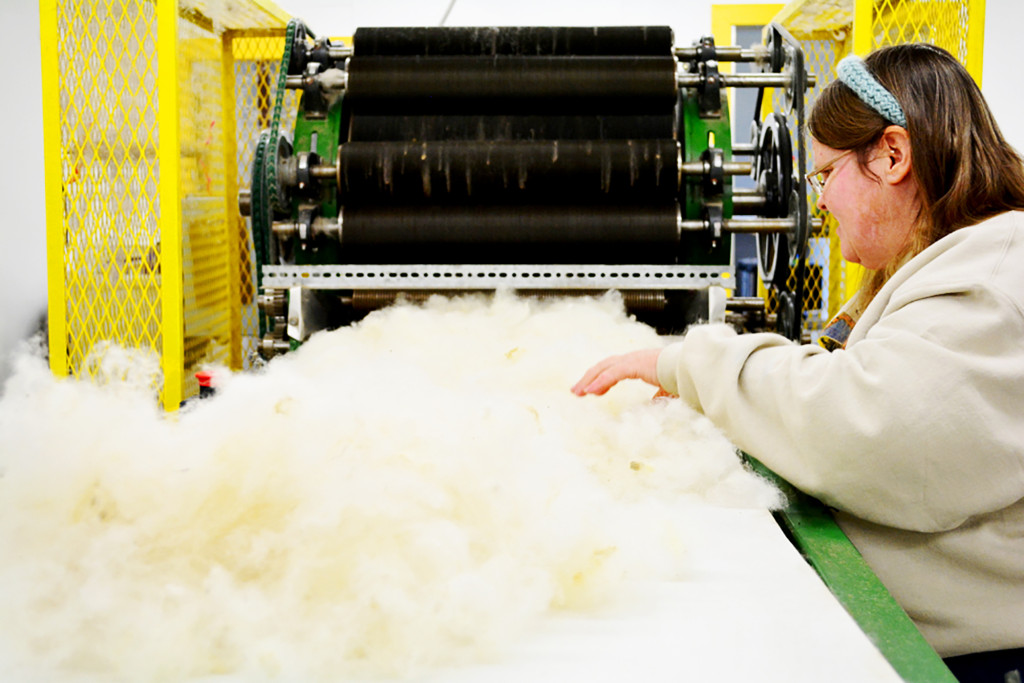
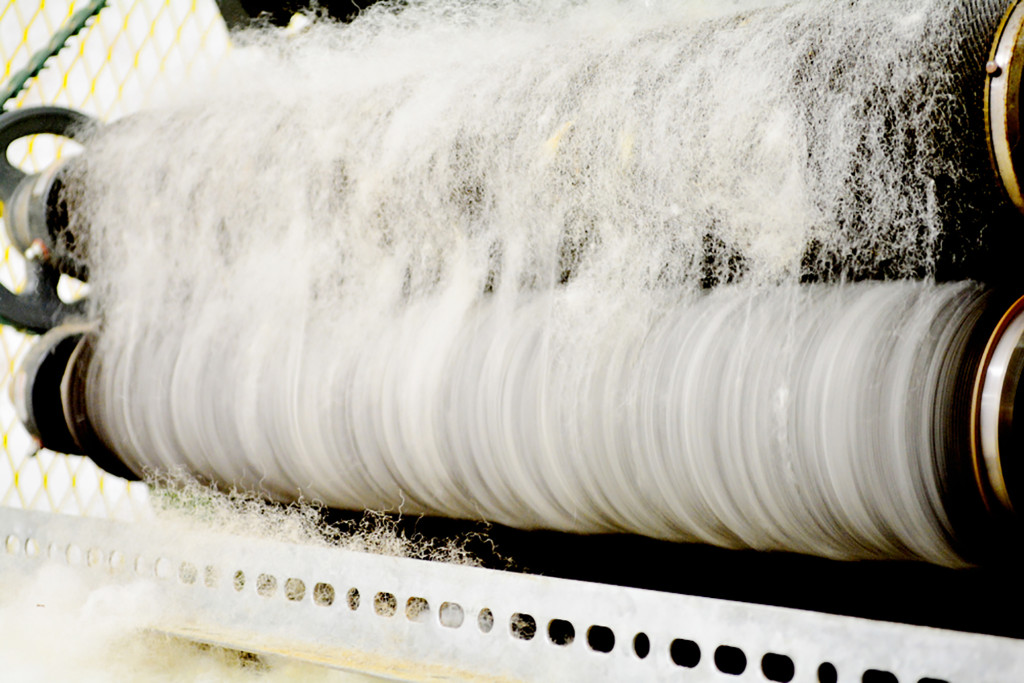
After the wool has completed its harrowing journey through the spikes, it comes out the other end in a smooth, round rope. This is called roving, and the wool is now ready to be spun into yarn.
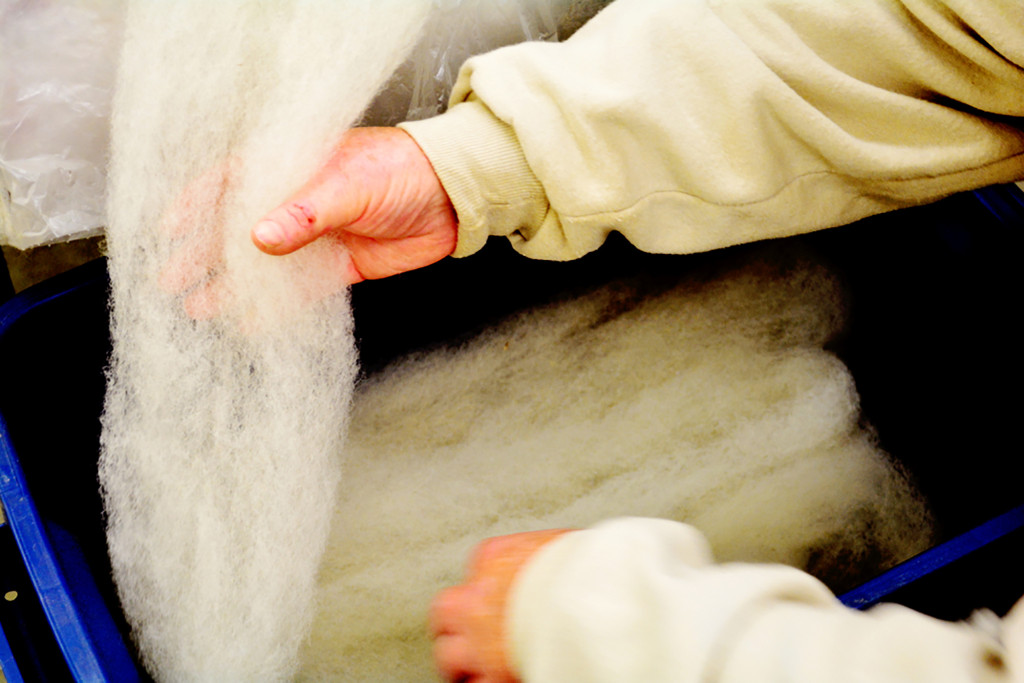
Wool is turned into roving, which can be spun into yarn.
It is not hyperbole to say that watching this transformation felt a little bit miraculous. Mere minutes before, the wool still looked pretty sheep-like; after minimal effort and only a few touches of human hands, it transformed into almost yarn. Carding machines are true feats of engineering, and it was one of those moments, like looking at the engine of a car or the wing of an airplane, when I suddenly feel deep gratitude for someone else’s genius.
Making Yarn
In a factory setting, the roving would then be spun into yarns of a small diameter, a size we’d think of as thread. There are two main categories of processing wool into yarns for fabric production: woolens and worsteds. Woolens are usually shorter, coarser fibers and spend less time being carded. They are made into fabrics like tweed. Worsteds go through extra steps in the carding process, resulting in softer and more comfortable fabrics.
Once the yarn is spun, a variety of treatments may be applied to it before it is woven or knit into fabric. There are several different chemical processes that can be applied to reduce or prevent felting, such as a chlorine wash to remove the fiber barbs or a resin that coats and smoothes the fibers. Wool takes on dye very well, as its naturally porous composition eagerly soaks up and holds the color.
As a fabric, wool has a variety of properties that make it as attractive a material today as it was a thousand years ago. Molecularly, wool fibers are tiny coils, which look like little springs. This makes them highly elastic and allows them to bounce back into shape even after lots of stretching. The coil structure also creates lots of space to trap air and moisture. This is what makes wool warm, but not overly so. Wool is also hydroscopic, meaning it can absorb up to thirty percent of its own weight in water without feeling damp. It’s one of the only fabrics that will still keep you warm when wet, and its naturally high moisture and nitrogen content means that it is extremely flame-resistant.
Not too bad for a prehistoric fabric!
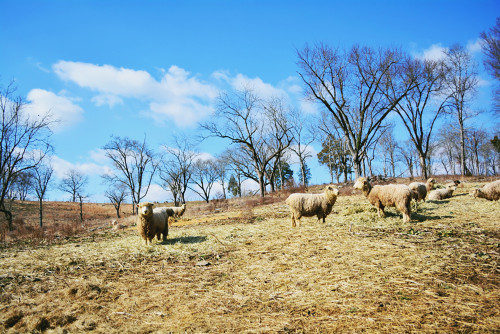
Sustainable Wool
As the garment industry tries harder to sell more, concerns about the impact on our resources and our environment are being raised. Fast fashion means that clothes are disposable; these cheaply made, polyester garments are finding their way into landfills quicker than ever, where they take as long to decompose as a plastic bag.
Wool offers an attractive alternative. As a natural protein, it decomposes quickly and easily. Sheep require few resources to raise and can eat just about anything, making their environmental impact minimal. In fact, farmers are now using sheep in place of herbicides and insecticides. They can be strategically grazed to control invasions of non-native plant species, being much cheaper—not to mention less toxic—than chemical weed killers. A recent study also found that grazing sheep in a wheat field post-harvest could significantly reduce the presence of insect pests in next year’s crop.
A Reciprocal Relationship
After the tour of their farm, Kim and Jane kindly take me out to lunch in Delina. The town café is also the town general store, and everyone inside knows each other like we’re in a 1950s television show. An ancient, black, pot-bellied stove hunkers down on the creaking floorboards, and burgers sizzle on a griddle. On Kim’s recommendation I order the fried green beans, which are crispy little bites of divinity. We all leave with hand pies to go, homemade and dropped off daily by a woman down the street.
On the drive back to the farm, Kim talks about her meticulous control over each year’s breeding process, and how she selects which ewe to breed to which ram. The lambs with the most desirable characteristics are kept to integrate into the flock’s gene pool. Others are sold, or, as Kim puts it, “go to the freezer,” discussing with a farmer’s bluntness the process of birth, life, and death from which we’re now all so removed.
Before I leave, we decide to take one last walk down to the Shetlands to see if Kim can coax one up close. Jane and I stay back to chat, and once again I’m surrounded by the Newfoundlands, who dwarf the Shetlands by nearly double.
A voice rings out, clear and strong, and I look to the distance to see Kim sitting on the ground in front of a sheep. I realize that she is singing. Her voice is trained, controlled, and clear as a bell, and remarkably incongruous with the raw damp of the farm. Her operatic vibrato lilts back to us in pieces, blown here and there by the breeze, the notes deliberate and solid.
A sheep takes a step toward Kim, seemingly entranced, and doesn’t notice as she slowly reaches up and puts her arm around it. She continues to sing and it relaxes against her, glassy eyes going distant as she scratches it under the chin.
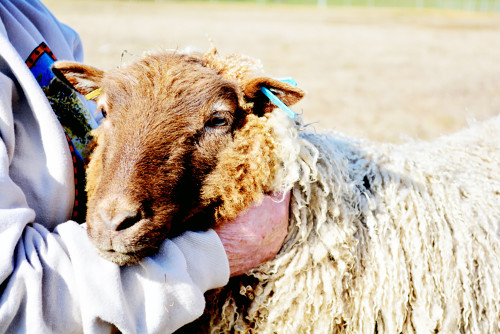
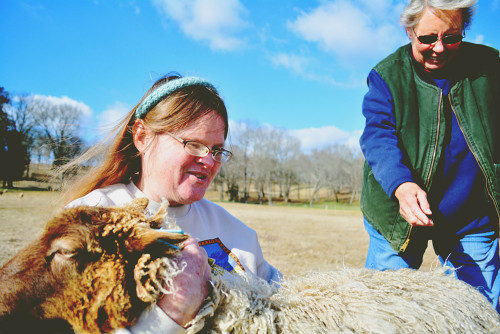
As we wait for Kim to work her magic, Jane apologizes that it’s winter and I couldn’t see the farm when it was prettier, as if she wishes she could alter the changing of the seasons just for my visit.
I look around. The dormant fields are tapestries of gold, sienna, and moss, and the skies above them are brilliant blue. Sheep lounge in the sun under the silvery bare trees, dotted over the rolling hills. The wind carries with it the sounds of birds and the trickling of thaw, and, quite noticeably, a pure sound that is the absence of traffic.
I tell her it’s ok.
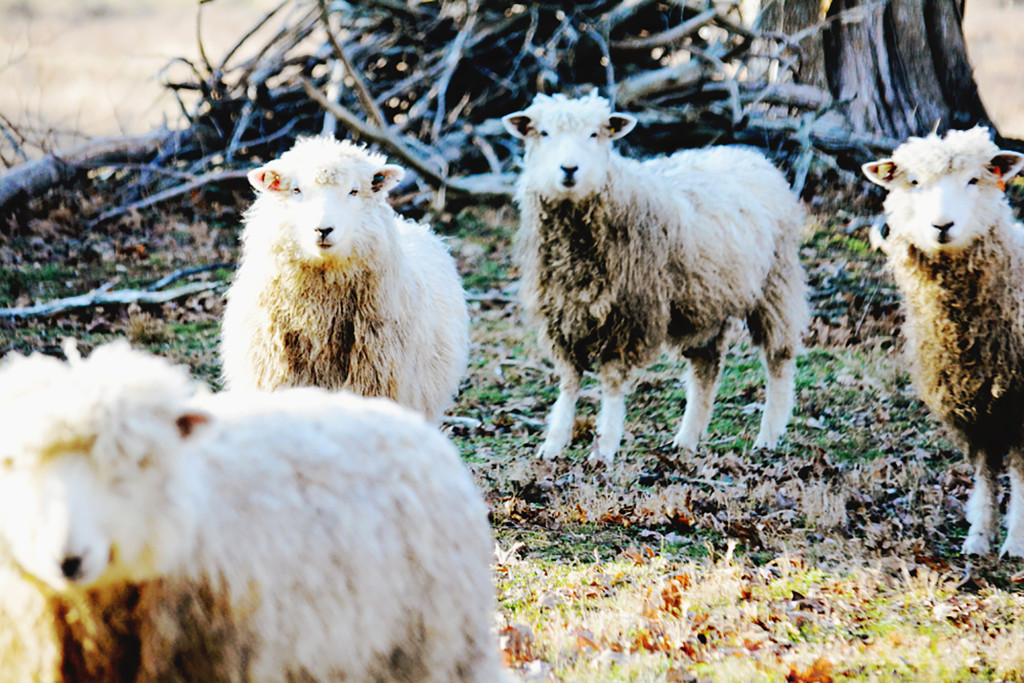
An earlier version of this story identified the spindle as a distaff. We regret the error. -Ed

